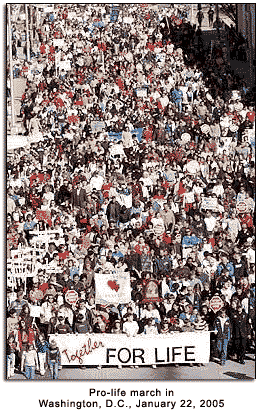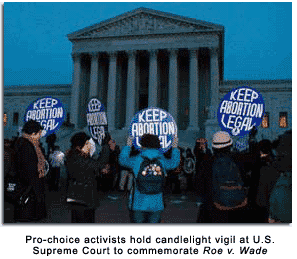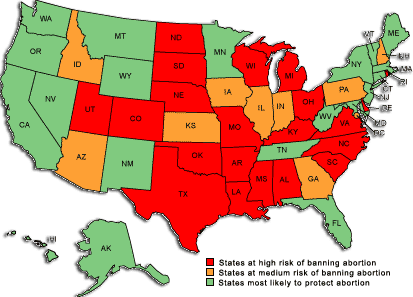The name Norma McCorvey is just a name to most Americans and the world. If the legal pseudonym Jane Roe¹ is brought up, most people immediately recognize it as a judicial milestone, etched with themes of fetal "right to life" against a woman's "right to privacy." The names are connected.
 The mention of Roe v. Wade immediately provokes a verbal, if not pugilistic, battleground. Few other decisions handed down by the U.S. Supreme Court have exerted such far-reaching ramifications, and generated so much controversy, as Roe.
The mention of Roe v. Wade immediately provokes a verbal, if not pugilistic, battleground. Few other decisions handed down by the U.S. Supreme Court have exerted such far-reaching ramifications, and generated so much controversy, as Roe.
Background
"The times they are a-changin'." In the Sixties, America was entrenched in a war it apparently could not win. The "Hippie Generation" was flourishing. Women across the country were demanding equal rights with men. They also demanded respect.
The Roe case could have involved any woman confronting an unwanted pregnancy. Norma McCorvey happened to be available to an aggressive young attorney² from Austin, Texas, to use as a test case challenging Texas law forbidding abortion.
It also could have been nearly any attorney in any state that held abortion to be a crime.
In Griswold v. Connecticut (1965), Sarah Weddington, the Texas attorney, saw the case as a potential precursor to the Roe case, provided it reached the Supreme Court. In Griswold, the court held that a "right of privacy" was an integral part of the Bill of Rights and the 14th Amendment's due process clause.
As a part of Griswold, constitutional protection was given to the "right of privacy," as applied to the possession of birth control pharmaceuticals.
The Roe case before the Supreme Court The first time Roe was heard before the court, in December 1971, the justices were not favorably impressed by the oral arguments, although Justice Harry Blackmun (appointed by Richard M. Nixon, and the junior associate of the court) wrote an opinion that would strike down the Texas law as "unconstitutionally vague."
This also was at a time of flux in the court's makeup: Justices Hugo Black (a holdover from the Franklin D. Roosevelt administration) and John Harlan (Dwight D. Eisenhower) had resigned from the court in September, and President Nixon was about to appoint two new justices.
At the time, those appointments could alter the final vote on Roe, so Chief Justice Warren Burger (a Nixon appointee) urged that the case be held over for re-argument at a time that the court would be at full strength. It would be October 1972 before re-argumentation took place.
The decision
The court issued its decision in January 1973: By a majority vote of 7-2, the court voted to strike down the Texas law. Justices Byron White (John F. Kennedy) and William Rehnquist (one of Nixon's new appointees) dissented.
A similar law in Georgia, the lesser-known Doe v. Bolton, was struck down by the same majority on the same day.
The defining opinion Justice Blackmun again wrote the majority opinion: That state laws outlawing abortion were struck down, allowing abortions in the first trimester, or three months, of pregnancy. After that period, abortions were allowed to safeguard the woman's health.
The court held that the word "Person" in the Constitution (narrative) "does not include the unborn." Further, after the first trimester, the state still has an interest in protecting the mother's health.
Regarding the "right of privacy" issue, the court found that although the Constitution (text) "does not explicitly mention any right of privacy," the court ruled that there was a "constitutional right of privacy in the 1st, 4th, 227:5th], 9th, and 14th amendments." The right to privacy was broad enough to "encompass a woman's decision whether or not to terminate her pregnancy."
 In addition, the knotty question of "whether a fetus can enjoy Constitutional protection is separate from the notion of when life begins," was not resolved by the court.
In addition, the knotty question of "whether a fetus can enjoy Constitutional protection is separate from the notion of when life begins," was not resolved by the court.
It should be noted that by the time the court considered the matter, McCorvey had given birth, which under "normal rules of the court," would have rendered the lawsuit moot.
The court saw otherwise, treating this case as an exception, in that they knew the decision and subsequent opinion they were about to make would cover similar suits in the future. They recognized that "pregnancy litigation seldom will survive much beyond the trial stage," thus denying due process to the plaintiff.
Dissenting justices White and Rehnquist voiced their disgust, calling the court's decision an "exercise of raw judicial power . . .(with no Constitutional support). The court simply fashions and announces a new constitutional right for pregnant mothers . . . ."
Ramifications The Roe decision immediately triggered protests across America, polarizing the nation into camps: "Pro-Life" and "Pro-Choice." Letter-writing campaigns to the Supreme Court, picket lines attempting to stop women from entering abortion clinics, targeting abortion doctors with harassment — even murder — all were the direct results of the decision.
Those of the more liberal camp, such as Justice Blackmun, continued to make their voices heard, praising Roe as "essential to women's equality and reproductive freedom."
In reaction to Roe, many states chose to limit certain rights to an abortion. Some of the laws that spun off the case dealt with requiring parental consent to obtain an abortion for minors, spousal consent laws, laws barring state funding for abortions, mandated waiting periods, requirements that certain informational pamphlets be read before proceeding with the abortion, and many more.
Legislation at the national level occurred in September 1976, when the "Hyde Amendment," essentially banning federal funding for abortions, was enacted. Gone, too, were abortions in overseas military hospitals, and international family-planning clinics could no longer receive federal aid.
In his opinion in the 2000 case Stenberg vs. Carhart, Justice Stephen Breyer (Bill Clinton) commented,
"Millions of Americans believe that life begins at conception and consequently that an abortion is akin to causing the death of an innocent child; they recoil at the thought of a law that would permit it. Other millions fear that a law that forbids abortion would condemn many American women to lives that lack dignity, depriving them of equal liberty and leading those with least resources to undergo illegal abortions with the attendant risks of death and suffering."The pendulum, however, was beginning to swing back to the right.
President Ronald Reagan, who favored legislative restrictions on abortions, created his infamous "litmus test" for federal judicial appointments. Justice Sandra Day O'Connor (Reagan) began to dissent on the court's abortion cases, claiming that the "trimester" stance was "unworkable." Burger, shortly before his retirement, advanced the notion that Roe should be "re-examined."
New associate justice Antonin Scalia (Reagan), who replaced Burger on the court, was known to be anti-Roe, but Robert Bork's nomination was scuttled by the liberal wing when it was feared that Roe might be overturned. Anthony Kennedy (another Reagan appointee) also was seen as a potential vote to overturn it.
And so it went.
 Challenges to Roe vs. Wade
Challenges to Roe vs. Wade
Squabbling among the justices was beginning to polarize even that venerable body.
In a key 1989 decision, Chief Justice Rehnquist sided with the 5-4 majority in Webster vs. Reproductive Health Services. Although he opposed overruling Roe, Rehnquist modified the trimester clause and upheld several abortion restrictions. Justice O'Connor concurred in refusing to overturn Roe. Justice Scalia refused to join in the plurality decision because it refused to overturn Roe. Justice Blackmun was furious because the plurality opinion "signaled doom for the right to an abortion."
When Roe supporters Justice William Brennan (Eisenhower) and Justice Thurgood Marshall (Lyndon B. Johnson) retired, their replacements, named by George H.W. Bush (Justices David Souter and Clarence Thomas), were thought to be conservative enough to help overturn Roe.
The court as a whole, did, in fact, reexamine Roe in the 1992 case Planned Parenthood vs. Casey, and upheld its validity, 5-4. State-level attempts to ban "partial-birth abortions" (a procedure performed during the fifth month of gestation or later) were also struck down by the high court along the same voting lines.
Ongoing controversy
Further attempts were made in Congress to legislate the banning of third-trimester abortions. Even George W. Bush entered the arena by proposing an amendment to the Constitution banning third trimester abortions. The case, at present essentially a class action suit, has now involved all three branches of the federal government.
In a strange twist of history, McCorvey, after giving birth, and after her conversion to Christianity, came down on the side of the Pro-Life movement.